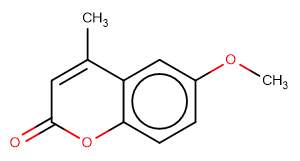
4-Methyl-6-Methoxycoumarin
CAS No. 6295-35-8
4-Methyl-6-Methoxycoumarin( —— )
Catalog No. M21303 CAS No. 6295-35-8
4-Methyl-6-Methoxycoumarin?is a natural product isolated from Eupatorium pauciflorum.
Purity : >98% (HPLC)
 COA
COA
 Datasheet
Datasheet
 HNMR
HNMR
 HPLC
HPLC
 MSDS
MSDS
 Handing Instructions
Handing Instructions
| Size | Price / USD | Stock | Quantity |
| 100MG | Get Quote | Get Quote |


|
| 200MG | Get Quote | Get Quote |


|
| 500MG | Get Quote | Get Quote |


|
| 1G | Get Quote | Get Quote |


|
Biological Information
-
Product Name4-Methyl-6-Methoxycoumarin
-
NoteResearch use only, not for human use.
-
Brief Description4-Methyl-6-Methoxycoumarin?is a natural product isolated from Eupatorium pauciflorum.
-
Description4-Methyl-6-Methoxycoumarin?is a natural product isolated from Eupatorium pauciflorum.
-
In Vitro——
-
In Vivo——
-
Synonyms——
-
PathwayOthers
-
TargetOther Targets
-
RecptorOthers
-
Research Area——
-
Indication——
Chemical Information
-
CAS Number6295-35-8
-
Formula Weight190.19
-
Molecular FormulaC11H10O3
-
Purity>98% (HPLC)
-
Solubility——
-
SMILESCC(c(cc(cc1)OC)c1O1)=CC1=O
-
Chemical Name——
Shipping & Storage Information
-
Storage(-20℃)
-
ShippingWith Ice Pack
-
Stability≥ 2 years
Reference
molnova catalog



related products
-
TLR7-agonist-1
TLR7-agonist-1 is a specific and effective Toll-like Receptor 7 (TLR7) agonist (LEC=0.4 μM).
-
17-Hydroxyisolathyro...
17-Hydroxyisolathyrol is a natural product.
-
NGI-1
NGI-1 is a a cell-permeable inhibitor of oligosaccharyltransferase (OST).can effectively reduce virus infectivity without affecting cell viability.



 Cart
Cart
 sales@molnova.com
sales@molnova.com


